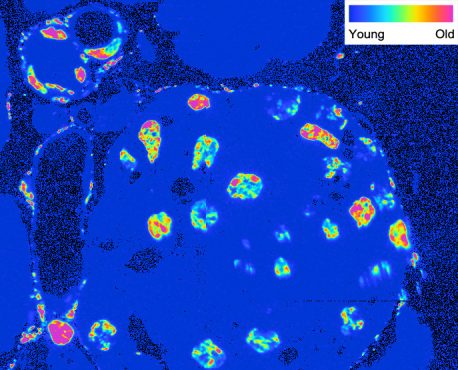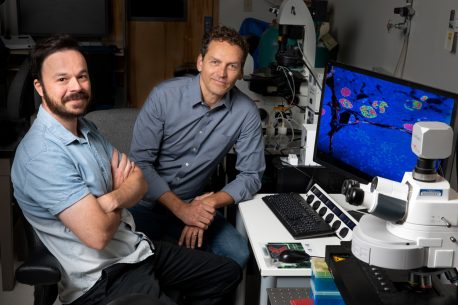Most neurons in the brain do not divide during adulthood and thus experience a long lifespan and age-related decline. Yet, largely due to technical limitations, the lifespan of cells outside of the brain was difficult to determine.

Click here for a high-resolution image.
Credit: Salk Institute
“Biologists have asked—how old are cells in an organism? There is this general idea that neurons are old, while other cells in the body are relatively young and regenerate throughout the organism’s lifetime,” says Rafael Arrojo e Drigo, first author and Salk staff scientist. “We set out to see if it was possible that certain organs also have cells that were as long-lived as neurons in the brain.”
Since the researchers knew that most neurons are not replaced during the lifespan, they used them as an “age baseline” to compare other non-dividing cells. The team combined electron isotope labeling with a hybrid imaging method (MIMS-EM) to visualize and quantify cell and protein age and turnover in the brain, pancreas and liver in young and old rodent models.
To validate their method, the scientists first determined the age of the neurons, and found that—as suspected—they were as old as the organism. Yet, surprisingly, the cells that line blood vessels, called endothelial cells, were also as old as neurons. This means that some non-neuronal cells do not replicate or replace themselves throughout the lifespan.
The pancreas, an organ responsible for maintaining blood sugar levels and secreting digestive enzymes, also showed cells of varying ages. A small portion of the pancreas, known as the islets of Langerhans, appeared to the researchers as a puzzle of interconnected young and old cells. Some beta cells, which release insulin, replicated throughout the lifetime and were relatively young, while some did not divide and were long-lived, similar to neurons. Yet another type of cell, called delta cells, did not divide at all. The pancreas was a striking example of age mosaicism, i.e., a population of identical cells that are distinguished by their lifespans.
Prior studies have suggested that the liver has the capacity to regenerate during adulthood, so the researchers selected this organ expecting to observe relatively young liver cells. To their surprise, the vast majority of liver cells in healthy adult mice were found to be as old as the animal, while cells that line blood vessels, and stellate-like cells, another liver cell type, were much shorter lived. Thus, unexpectedly, the liver also demonstrated age mosaicism, which points to potential new paths of regenerative research for this organ.

Click here for a high-resolution image
Credit: Salk Institute
On a molecular scale, a selection of the observed long-lived cells contained protein complexes displaying age mosaicism. For example, the primary cilia (hair-like appendages on the outside of cells) of beta cells in the pancreas and neurons contained protein regions of vastly different lifespans. In stark contrast, the cells in the liver contained no long-lived proteins at all.
“Thanks to new visualizing technologies we are able to pinpoint the age of cells and their supramolecular complexes more accurately than ever before. This opens new doors for studying all cells, tissues and organs in normal and in disease states,” says Mark Ellisman, Distinguished Professor of Neurosciences at UC San Diego’s School of Medicine and co-leader of the study with Hetzer. His laboratory, the National Center for Microscopy and Imaging Research, developed and provided the new tissue imaging methods for correlated multi-scale and multi-modal microscopy. These methods provided the new and enabling technologies that allowed this study to be carried out.
“Determining the age of cells and subcellular structures in adult organisms will provide new insights into cell maintenance and repair mechanisms and the impact of cumulative changes during adulthood on health and development of disease,” adds Hetzer. “The ultimate goal is to utilize these mechanisms to prevent or delay age-related decline of organs with limited cell renewal.”
Next, the authors plan to decipher the difference in lifespans for nucleic acids and lipids. They also want to understand how age mosaicism relates to health and diseases such as type 2 diabetes.
Other authors included Swati Tyagi of Salk; Varda Lev-ram, Ranjan Ramachandra, Thomas Deerinck, Eric Bushong and Sebastien Phan of UC San Diego; Victoria Orphan of the California Institute of Technology; and Claude Lechene of Brigham and Women’s Hospital.


